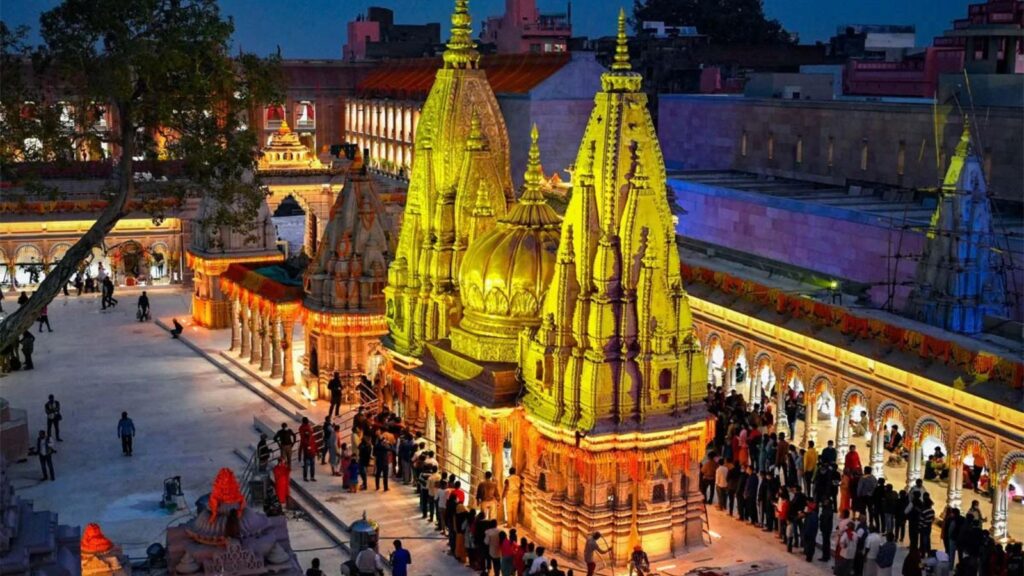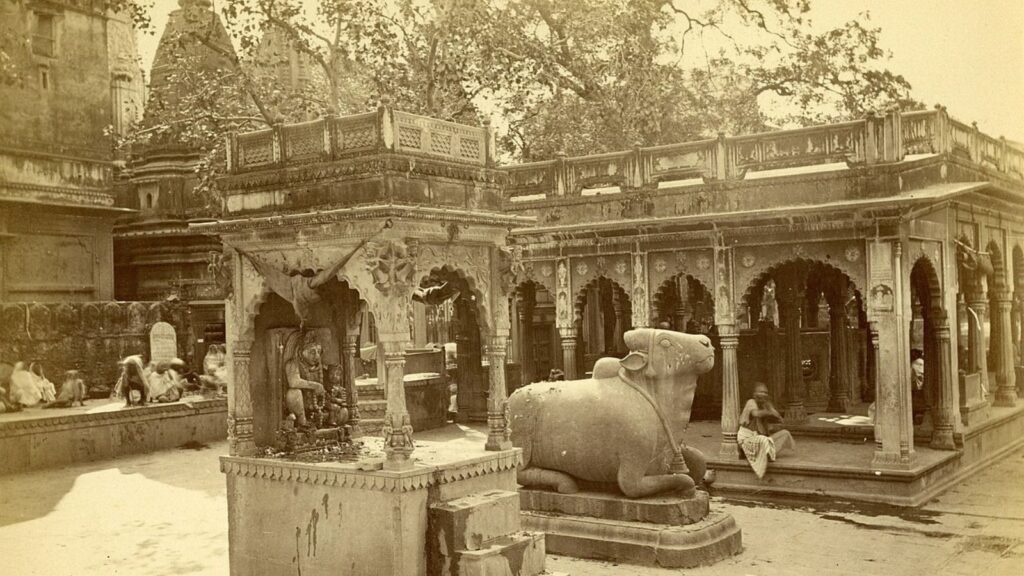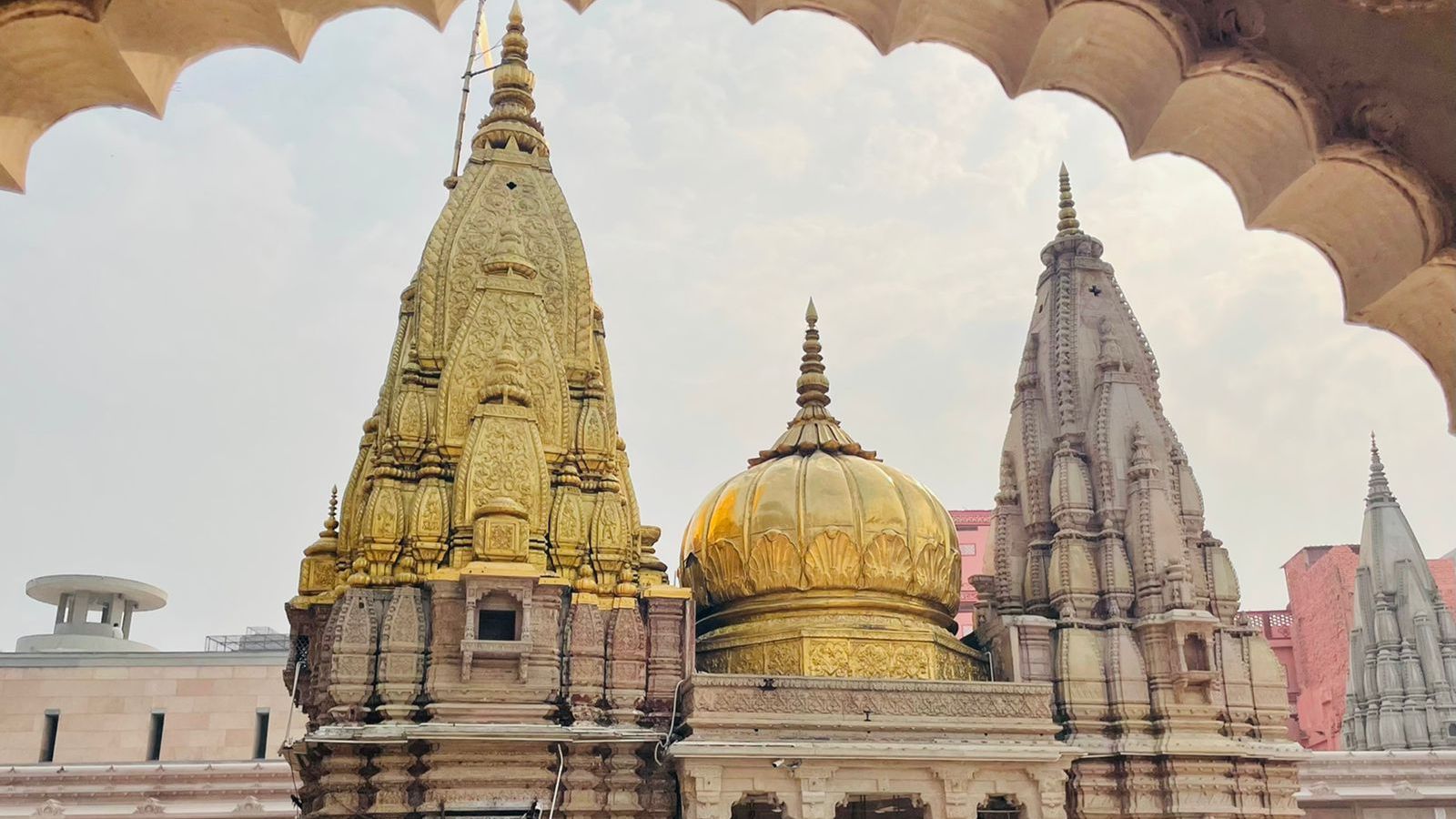The Kashi Vishwanath Temple in Varanasi is among the most revered shrines of Hinduism. Dedicated to Lord Shiva, it is one of the twelve Jyotirlingas, where Lord Shiva is manifested as a brilliant “column of light”. References in the Skanda Purana and other texts suggest the temple’s antiquity stretches back thousands of years, with legends placing its origins more than 3,500 years ago. Though the temple has been repeatedly destroyed and rebuilt, it has always remained the spiritual heart of Kashi.
The Divine Linga and Worship
The presiding deity, Lord Vishwanath or “Ruler of the Universe,” is worshipped in the form of a Jyotirlinga. The linga, a black stone measuring about 60 cm in height and 90 cm in circumference, rests on a silver altar. It symbolizes the cosmic pillar of light that connects the earthly and divine realms, and is believed to grant moksha (liberation) to devotees. According to legend, Shiva appeared as an endless column of light to settle a dispute between Brahma and Vishnu, affirming his supremacy and establishing Kashi as a spiritual epicenter.
Daily worship follows a strict rhythm, with Mangala Aarti at dawn, a series of offerings through the day, and Shayan Aarti at night. Mondays, the month of Shravan, and the festival of Mahashivaratri are very significant, when Rudrabhishek chants and elaborate rituals draw vast congregations.

Historical Struggles and Reconstruction
The temple has faced repeated cycles of destruction throughout its history. The original shrine, known as Adi Vishveshwar, was demolished by Muhammad of Ghor in 1194 after the Battle of Chandawar, in which he defeated Raja Jayachandra of Kannauj, one of the most powerful rulers of North India at the time. Following this victory, his army marched into the Ganga plain, sacked Varanasi, and demolished many temples, including the original Vishwanath Mandir. Later, the shrine was rebuilt but again demolished in 1669 by Aurangzeb, who ordered the construction of the Gyanvapi Mosque on its foundation, while the sacred Gyanvapi Well, meaning “Well of Knowledge,” remained a point of continuity. According to some accounts, priests concealed the linga in this well to protect it during invasions.
Despite these setbacks, devotion to Shiva in Kashi never ceased. The present temple was commissioned in 1780 by Maharani Ahilyabai Holkar of Indore, a devout Maratha queen remembered for restoring many Hindu shrines across India. Later patrons expanded and embellished the complex. In the nineteenth century, Maharaja Ranjit Singh, the Sikh ruler of Punjab, donated gold to sheath the main shikhara, giving the temple its distinctive gilded profile. Today the complex also houses shrines to Avimukteshwar, Vishnu, and Kaal Bhairav, reflecting the city’s layered sacred geography.
The Mysterious Nandi and Gyanvapi Connection
A striking feature of the temple is a seven-foot statue of Nandi, the vahana of Lord Shiva, seated in the eastern courtyard. Gifted by the Rana* of Nepal in the 1860s, it does not face the present sanctum but looks instead toward the Gyanvapi Mosque precinct. This orientation is believed to mark the site of the original temple destroyed by Aurangzeb, symbolizing Nandi’s eternal devotion to Shiva’s presence there.

The Nandi in the temple courtyard facing the Gyanvapi Mosque (not seen in the pic),
believed to be the original site of the Vishwanath Mandir
Spiritual and Cultural Significance
The Kashi Vishwanath Temple is inseparable from Varanasi’s identity as Avimukta, the city never abandoned by Shiva. It is believed that Shiva imparts the Taraka Mantra here at the time of death, guiding souls to liberation. Pilgrims often combine darshan at the temple with visits to the nearby Annapurna Devi temple, affirming the union of divine grace and sustenance. The Panchkroshi Yatra, a sacred pilgrimage circuit around the city, places Vishwanath at its heart, further enshrining the temple in Kashi’s spiritual geography.
In recent years, the Kashi Vishwanath Corridor project has improved access by linking the temple directly to the Ganga, restoring ancient sightlines and easing the flow of pilgrims. Today, millions visit annually, making it not only one of the holiest places of worship but also a living symbol of devotion of continuity.
Key places to visit around the temple:
- Annapurna Devi Temple (100 m) – Goddess of nourishment; usually visited after Vishwanath darshan.
- Gyanvapi Well (inside mosque complex, adjacent) – Access to general public is restricted; deeply tied to the temple’s history.
- Kaal Bhairav Temple (800 m) – Dedicated to Shiva’s fierce guardian form, regarded as the protector of Kashi.
- Vishalakshi Temple (200 m) – A Shakti Peetha, where Sati’s earring is believed to have fallen.
- Dashashwamedh Ghat (500 m) – Famous for the evening Ganga Aarti.
- Manikarnika Ghat (700 m) – The oldest and holiest cremation ghat, associated with moksha.
- Nepali Mandir (Kathwala Temple) (1 km) – Pagoda-style Shiva temple built by the King of Nepal.
- Scindia Ghat and Submerged Shiva Temple (1 km) – Known for its partially submerged leaning temple in the Ganga.
* The Rana of Nepal, a devout patron of Shiva, gifted the seven-foot Nandi in the 1860s that faces the Gyanvapi Mosque. His family also built the nearby Nepali Mandir on Lalita Ghat, a pagoda-style Shiva temple, reflecting Nepal’s enduring spiritual bond with Varanasi.
Pic. Credits of Nandi: John Edward Sache – https://collections.carli.illinois.edu/digital/collection/knx_ward/id/116/



